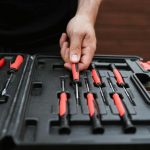When you're applying rivets, safety should always be your top priority. It's crucial to wear the right protective gear, prepare your materials adequately, and use the proper tools. You might be surprised at how much technique matters, from pre-drilling to maintaining alignment. Each step plays a vital role in ensuring a secure application, but are you aware of the specific practices that can make or break your project? Let's explore the details that could significantly impact your rivet installations and ensure lasting results.
Table of Contents
Key Takeaways
- Always wear appropriate safety gear, including eye and hearing protection, to safeguard against potential hazards during rivet application.
- Prepare materials by cleaning and inspecting surfaces to ensure strong, durable rivet joints and prevent corrosion or failure.
- Utilize the correct tools, including a rivet gun and drill bits, to ensure precise installation and avoid damaging rivets.
- Maintain proper alignment and consistent pressure during installation to achieve uniform rivet shape and prevent joint failure.
Understanding Rivet Types
To choose the right rivet for your project, you first need to understand the different types available and their specific applications. Rivets come in various forms, and selecting the appropriate one can make a significant difference in your project's success.
Solid rivets are the most traditional type, often used in heavy-duty applications like aircraft and structural steel. They provide excellent strength but require proper tools for installation.
If you're working with softer materials, consider blind rivets. These are versatile and can be installed in tight spaces where you can't access both sides of the workpiece.
Another option is the tubular rivet, which features a hollow shaft that makes it lightweight and flexible. They're often used in leather and fabric applications.
For high-stress environments, you might want to look at structural rivets, which are designed for maximum strength and durability.
Lastly, self-plugging rivets can simplify your work by eliminating the need for a backup plate, as they form a strong bond as they're installed.
Essential Safety Gear
When you're applying rivets, wearing the right safety gear is crucial.
You need to protect your eyes from flying debris and your ears from the loud noises that come with the job.
Let's explore why eye and hearing protection are non-negotiable.
Eye Protection Importance
Wearing proper eye protection is crucial, as it shields you from flying debris and potential hazards while working with rivets. Whether you're drilling, hammering, or fastening, the risk of small particles and rivet fragments can easily lead to serious eye injuries. That's why wearing safety goggles or face shields should be a non-negotiable part of your safety gear.
Here's a quick comparison of eye protection options:
| Type of Eye Protection | Description |
|---|---|
| Safety Glasses | Lightweight, impact-resistant |
| Goggles | Full coverage, seal against debris |
| Face Shields | Protects entire face, ideal for larger debris |
| Prescription Safety | Customized for vision correction, safety compliant |
| Wraparound Glasses | Provides peripheral protection |
Always ensure your eye protection fits comfortably and meets safety standards. Check for any scratches or damages before starting your work. Remember, taking a few moments to put on the right gear can prevent a lifetime of vision loss. Prioritize your safety, and make eye protection a habit every time you handle rivets.
Hearing Protection Necessity
Hearing protection is often overlooked, but it's essential for safeguarding your ears from the loud noises generated during riveting tasks. The impact of riveting can produce sound levels that exceed 85 decibels, which can lead to permanent hearing damage if you're not careful.
When you're working in environments with high noise levels, it's crucial to wear appropriate hearing protection. Options like earmuffs and earplugs can significantly reduce the risk of hearing loss. Make sure to choose gear that fits well and is comfortable, as you'll likely be wearing it for extended periods.
Always remember to check the Noise Reduction Rating (NRR) of your hearing protection. A higher NRR means greater sound attenuation, which is vital when you're in a noisy workspace. Regularly inspect your hearing protection for wear and tear, as damaged gear won't provide the necessary protection.
In addition to wearing hearing protection, consider implementing noise reduction measures in your workspace. This can include sound barriers or using quieter tools whenever possible. By prioritizing hearing safety, you'll ensure a healthier work environment and protect your hearing for the long term.
Preparing the Materials
Before you start riveting, ensure all materials are clean, dry, and free from debris to achieve a strong bond. This step is crucial because any contaminants can weaken the integrity of your rivet joints. You want to ensure that your work results in lasting durability, so take the time to prep your materials properly.
Here's a quick reference table to help you remember key preparation tips:
| Material Type | Prepping Action | Importance |
|---|---|---|
| Metal | Remove rust and oil | Prevents corrosion and failure |
| Wood | Sand surfaces smooth | Ensures proper adhesion |
| Plastic | Clean with mild detergent | Avoids chemical reactions |
| Composite | Inspect for damage | Maintains structural integrity |
| Fabric | Wash and dry thoroughly | Eliminates weak spots |
Proper Tools and Equipment
When you're ready to apply rivets, having the right tools is crucial.
You'll need essential riveting tools to ensure accuracy and efficiency, along with personal protective equipment to keep yourself safe.
Let's explore what you'll need to get the job done right.
Essential Riveting Tools
To achieve a successful riveting job, you'll need the right tools and equipment tailored to your specific project.
Start with a quality rivet gun, which is crucial for applying pressure and ensuring a secure fit. Choose between hand-held or pneumatic options, depending on the scale of your work and your comfort level.
Next, you'll need a selection of rivets in various sizes and materials, such as aluminum, steel, or stainless steel, to match your project's requirements.
Don't forget a set of drill bits for creating accurate holes; make sure they correspond to the rivet sizes you plan to use.
Anvil tools are also essential, as they help shape and secure the rivets properly.
A good set of pliers will assist you in holding and manipulating the rivets during installation.
Additionally, a measuring tape and square will ensure precise alignment and spacing.
Personal Protective Equipment
Wearing the right personal protective equipment (PPE) is crucial for ensuring your safety while working with rivets. When you're handling tools and materials, the right gear protects you from potential hazards like flying debris or sharp edges.
Here's what you need to have:
- Safety Glasses: These protect your eyes from metal shavings and other particles that could cause injury during the riveting process.
- Gloves: Durable gloves offer grip and protect your hands from cuts and scrapes. Make sure they're suitable for the materials you're working with.
- Steel-Toed Boots: Strong footwear can shield your feet from heavy items that might drop, as well as sharp objects on the ground.
- Hearing Protection: If you're using power tools, earplugs or earmuffs can help prevent hearing damage from loud noises.
Techniques for Secure Application
Ensuring a secure application of rivets requires careful alignment and consistent pressure during installation. Start by properly positioning the rivet, ensuring it fits snugly in the pre-drilled holes. You'll want to maintain a straight line between the rivet and the rivet gun to avoid misalignment. Once positioned, apply even pressure to the rivet gun to ensure a tight fit and prevent deformation.
Here are some key techniques to follow during the application process:
| Technique | Description | Benefits |
|---|---|---|
| Pre-drilling | Drill holes slightly larger than rivet diameter | Reduces material stress |
| Use of backing bar | Place a backing bar behind the rivet | Distributes force evenly |
| Sequential riveting | Install rivets in a staggered pattern | Enhances structural integrity |
| Maintain consistent speed | Keep a steady pace when applying pressure | Ensures uniform rivet shape |
| Final inspection | Check each rivet after installation | Confirms secure application |
Inspecting Rivet Integrity
Inspecting rivet integrity is crucial for maintaining the strength and reliability of your assembly. Regular checks can help you identify issues before they lead to failure.
Here are four key aspects to focus on during your inspection:
- Visual Inspection: Look for obvious signs of damage, such as cracks, corrosion, or unusual wear. A thorough visual check can reveal potential weaknesses.
- Rivet Head Condition: Ensure the rivet heads are intact and properly formed. Any deformation might indicate improper installation or excessive load.
- Joint Tightness: Check the tightness of the joint. If you notice any looseness, it could compromise the assembly's performance.
- Material Compatibility: Verify that the rivets are made of compatible materials with the joined components. Mismatched materials can lead to corrosion and failure over time.
Handling and Storage Tips
Properly handling and storing rivets is essential to prevent damage and maintain their integrity for future use.
Start by keeping your rivets in a clean, dry environment. Moisture can lead to corrosion, so consider using airtight containers or bags to protect them from humidity.
When you're ready to use the rivets, handle them with care. Avoid dropping or striking them against hard surfaces, as this can deform the rivet's shape. Always pick them up gently and store them in an organized manner to prevent mixing different sizes or types.
Label your storage containers clearly, so you can quickly find the rivets you need without rummaging through them. If you're working with a large batch, only take out what you need for the task at hand to minimize exposure to the elements.
Additionally, keep rivets away from extreme temperatures and direct sunlight, as these conditions can compromise their material properties.
Frequently Asked Questions
What Should I Do if a Rivet Fails During Application?
If a rivet fails during application, stop immediately. Assess the situation, remove any damaged parts, and determine the cause. Replace the rivet and ensure your tools are functioning properly before continuing the work.
Can I Use Rivets on Plastic Materials?
You can use rivets on certain plastic materials, but it's crucial to choose the right type of rivet. Ensure the plastic can withstand the stress and heat generated during the riveting process to avoid damage.
How Do Environmental Factors Affect Rivet Performance?
Environmental factors like temperature, humidity, and exposure to chemicals can significantly affect rivet performance. You should consider these conditions before installation, as they can lead to corrosion, weakening, or failure of the rivets over time.
Are There Specific Regulations for Rivet Applications in Construction?
Yes, there are specific regulations for rivet applications in construction. You'll need to consult local building codes and safety standards to ensure compliance, as these regulations help maintain structural integrity and worker safety on site.
What Are the Signs of Fatigue in Riveted Joints?
You'll notice signs of fatigue in riveted joints through visible cracks, looseness, or unexpected movement. Check for rust, deformation, or abnormal wear patterns, as these indicate potential failure and need immediate inspection or repair.
- How Does Ring Spun Cotton Affect Garment Fit and Shape Retention? - August 13, 2024
- What Are the Challenges in Producing Ring Spun Cotton? - August 13, 2024
- Is Ring Spun Cotton Suitable for Plus-Size Clothing? - August 13, 2024







